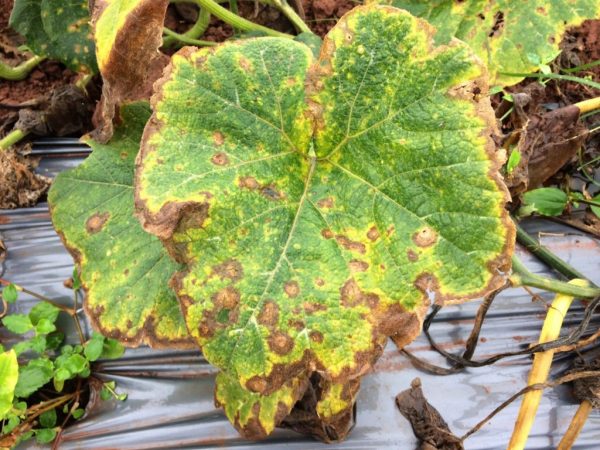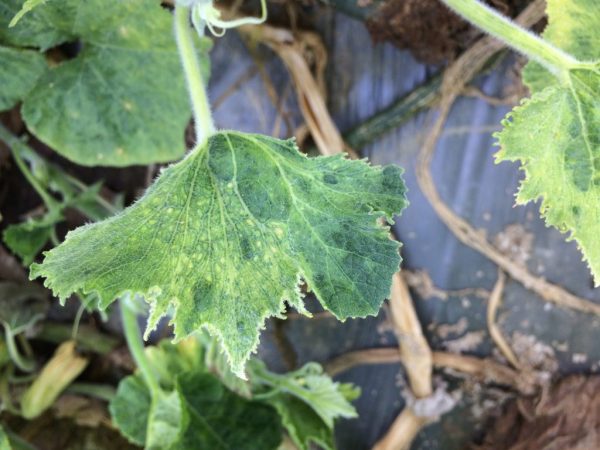Causes of yellowing pumpkin
There are several reasons why pumpkin leaves turn yellow. More often, yellowed foliage and ovaries are the result of improper care during cultivation. However, in some cases, this is a sign of disease and pest attacks. Let's look at everything in order.

Causes of yellowing pumpkin
Improper care
Subject to the agricultural technology of cultivating a vegetable, problems rarely arise: the leaves are usually green, which is a confirmation of the photosynthesis taking place in them, and the vegetable itself gives a good harvest.
If the leaves and ovaries of the pumpkin turn yellow and dry, this is a signal of improper care.
Temperature regime
A sharp temperature drop, prolonged heat and prolonged cold snap equally affect the development of the plant, causing severe stress in it. It does not matter in which direction the regime deviated.
Unsuitable weather conditions are one of the main reasons why pumpkin leaves turn yellow.
- With the onset of cold weather, the pumpkin foliage freezes, its edges dry, and the plates themselves turn yellow. The vegetable stops feeding, stops growing, the ovaries do not appear at all, or the formed ones do not form into fruits, but crumble.
- With an increase to 32 ° or more, pollination does not occur, the inflorescences dry and fall off.
Seeds are sown after the threat of frost has passed, and the soil warms up to a temperature of at least 12 ° C, optimally 15-18 ° C.
Agrotechnics
Compliance with agricultural techniques when planting pumpkin is a condition for the correct development of a vegetable crop.
The basic rules are:
- pre-sowing seed treatment;
- regular cleaning of weeds;
- disinfection of soil and equipment;
- autumn digging of ridges;
- changing planting sites and choosing the right predecessors in accordance with the recommendations of the crop rotation.
Watering
In the process of caring for a planted pumpkin, gardeners often exceed the norms and frequency of watering.
Irrigation should be suitable for weather conditions:
- abundant watering is required only at the onset of a hot period, while the plant is irrigated under the root in the evening hours, and during the period of solar activity they make sure that water does not fall on the foliage, a suitable water temperature is 20-27 ° C;
- in cool regions, watering is reduced to a minimum, resorting to it only when the soil dries out.
Lack of nutrition and overabundance of minerals

Poor care can kill a plant
Due to the lack of some elements important for the development of the pumpkin, the leaves dry and fall off.
For full growth, the following components are required:
- nitrogen;
- potassium;
- manganese;
- molybdenum;
- sulfur;
- iron;
- boron;
- copper.
Replenish nutritional deficiencies with regular feeding. Minimum amount of fertilization:
- after planting seedlings in open soil or when emerging on seedlings planted by the seed method, 3-4 leaves;
- at the flowering stage;
- with the onset of fruiting.
The exact opposite reason for the dropping of the ovaries and drying out of the foliage is an overabundance of nutrients due to frequent feeding.
Overweight pumpkin whips and thick green mass are a tip for reducing fertilization. Most often, gardeners are faced with an excess of nitrogen.
Diseases
- Root rot causes yellowing of foliage, its causative agent is a fungus that affects the root system and disrupts metabolic processes;
- Chlorosis - leads to a rapid, uncharacteristic thickening and yellowing of foliage due to impaired photosynthesis, appears due to a lack of potassium and sulfur with simultaneous sharp changes in temperature;
- Powdery mildew and its false type, peronosporosis, are fungal diseases that manifest themselves in the form of white blooms (spore compounds), under which the foliage changes color;
- Anthracosis - leads to yellowness and subsequent fall of foliage, getting to the root collar, causes malnutrition, which causes the death of the culture.
Control methods
Vegetable crops are treated with chemical and folk remedies:
- in the fight against chlorosis, with a lack of potassium, wood ash (200 g per 10 l of water) and potassium fertilizer complexes (20-25 g / m²) are introduced;
- against downy mildew (peronosporosis), plants are treated with Bordeaux liquid with a concentration of 1%, urea (10 granules per 10 l of water) or Strobi, Kuproksat, Oxykhom preparations;
- when signs of powdery mildew appear, they use fungicides - Karatan, Topaz, Fitosporin and spraying with solutions based on milk whey, which is diluted in water (1:10);
- Pre-sowing soaking of seeds in copper salts (solution with a concentration of 0.5%) or in a combination of iron and boron (solution with a concentration of 0.25%) helps to fight root rot, if the plant is damaged at the root collar, the upper soil layer is removed, fresh earth is added and poured with an ash solution (200 g per 10 l of water), the root collar is additionally sprayed with Fundazol with a concentration of 1%;
- for the treatment of pumpkin from anthracosis, they are treated with Bordeaux liquid with a concentration of 1% or 90% copper oxychloride.
Parasites

Pests can cause yellowing of leaves.
- Spider mite - settles on the underside of the leaf plate, enveloping it with cobwebs, feeds on plant sap through punctures in the tissues, as a result of which the leaves become speckled, acquire a yellow color and dry, with a massive attack, the ovaries fall off and the fruits stop developing;
- Sprout fly - special harm is caused not by adults, but from larvae that penetrate into the stem and feed on plant sap and soft tissues;
- Aphids - settle on the stems and the lower leaf layer in colonies, suck out the plant sap, affect mainly inflorescences, shoots and ovaries, does not allow fruits to develop.
Control methods
Pest control is also carried out with chemicals and folk methods:
- against spider mites, regular weeding is carried out and insect repellent plants are planted, for example, calendula,
- planting from a sprout fly is sprayed with ammonia or hydrogen peroxide (1 tsp per 1 liter of water);
- in the fight against melon aphids, they use foliar dressings with phosphorus and potassium (20 g of superphosphate, 10 g of potassium chloride per 10 l of water), as well as spraying infusions (50 g of tobacco, 10 g of laundry soap per 10 l of water, 400 g of ash, 50 g of laundry soap per 10 l of water, 100 g of onion per 10 l of water).
An integrated measure against pests is the treatment of plantings with insecticides, for example, Biotlin in a solution with a concentration of 5 ml per 10 liters of water.
Preventive measures
As already mentioned, if the leaves of the pumpkin turn yellow, it means that the rules of care have been violated or the vegetable is sick.
Fixing the problem is always difficult, and there is a risk of crop loss, so prevention is best.
Preventive measures are aimed at creating an environment in which the risk of disease and pests is minimized.
Agricultural techniques
- removal of plant residues from the garden, in which they can survive for the winter and subsequently activate pathogens, fungi and insect larvae;
- changing the planting site of the pumpkin, returning to its original place only after 3-4 years;
- sowing seeds and seedlings in dry, sunny weather in moist soil;
- regular loosening of row spacings, which reduces moisture evaporation and reduces the amount of watering, increases the penetration of air currents to the roots;
- pinching the stems, leaving up to 4 ovaries, forming a bush in 2 stems, which supports the full nutrition of the whole plant.
Chemical and folk remedies
- carry out pre-sowing seed treatment, make it permissible by soaking before planting in a weak solution of potassium permanganate;
- twice during the growing season, the plantings are sprayed with Bordeaux liquid to prevent the appearance of fungal infections;
- choose pest-resistant varieties;
- increase the immunity of plants by introducing fertilizer complexes and organic matter;
- plantings are sprayed with infusions to repel pests (with garlic, onions, wood ash, tobacco);
- when the primary sign of a lesion appears, they are treated with fungicidal and insecticidal agents.

